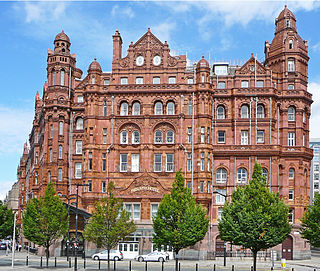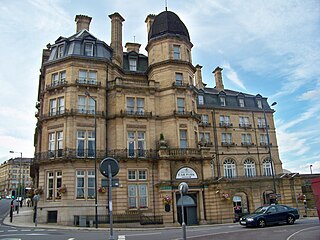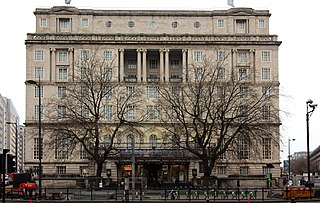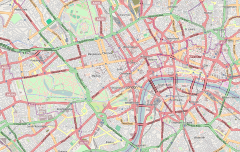
Tower 42 is a 183 metres (600 ft) skyscraper in the City of London. It is the fifth-tallest in the City and fifteenth-tallest in Greater London. Its original name was the National Westminster Tower, having been built to house NatWest's international headquarters. Seen from above, the shape of the tower resembles that of the NatWest logo.

Threadneedle Street is a street in the City of London, England between Bishopsgate at its northeast end and Bank junction in the southwest. It is one of nine streets that converge at Bank. It lies in the ward of Cornhill.

The Royal Exchange in London was founded in the 16th century by the merchant Sir Thomas Gresham on the suggestion of his factor Richard Clough to act as a centre of commerce for the City of London. The site was provided by the City of London Corporation and the Worshipful Company of Mercers, who still jointly own the freehold. It is trapezoidal in shape and is flanked by Cornhill and Threadneedle Street, which converge at Bank junction in the heart of the City. It lies in the ward of Cornhill.

Sir John Houblon was the first Governor of the Bank of England from 1694 to 1697.

The Midland Hotel Manchester, often referred to simply as The Midland, is a grand hotel in Manchester, England. Opened in September 1903, it was built by the Midland Railway to serve Manchester Central railway station, its northern terminus for its rail services to London St Pancras. It faces onto St Peter's Square. The hotel was designed by Charles Trubshaw in a highly individualistic Edwardian Baroque style. It is a Grade II* listed building.

100 King Street, formerly the Midland Bank, is a former bank premises on King Street, Manchester, England. It was designed by Edwin Lutyens in 1928 and constructed in 1933–35. It is Lutyens' major work in Manchester and was designated a Grade II* listed building in 1974.
Midland Bank Plc was one of the Big Four banking groups in the United Kingdom for most of the 20th century. It is now part of HSBC. The bank was founded as the Birmingham and Midland Bank in Union Street, Birmingham, England in August 1836. It expanded in the Midlands, absorbing many local banks, and merged with the Central Bank of London Ltd. in 1891, becoming the London City and Midland Bank.

Birmingham Curzon Street railway station was a railway station in central Birmingham, England, opening in 1838 and closed to passengers in 1893 but remaining open for goods until 1966. The station was used by scheduled passenger trains between 1838 and 1854 when it was the terminus for both the London and Birmingham Railway and the Grand Junction Railway, with lines to London, Manchester and Liverpool respectively. Excursion trains ran until 1893 after which only goods trains operated until closure in 1966. More recently, the surviving Grade I listed entrance building was used for occasional art events.

This article describes the hotels in London, England.

Cornhill is a ward and street in the City of London, the historic nucleus and financial centre of modern London. The street runs between Bank junction and Leadenhall Street.

Beeston railway station is a Grade II listed railway station on the Midland Main Line which serves the town of Beeston in Nottinghamshire, England. It lies 3.2 miles (5.1 km) south-west of Nottingham railway station, and 750 metres (0.5 mi) south-east of Beeston transport interchange for local buses and Nottingham Express Transit trams. The station is managed by East Midlands Railway.

Gunthorpe is a village and a civil parish in the English county of Norfolk. The village is 8.6 miles east north east of the town of Fakenham, 14.9 miles west south west of Cromer and 122 miles north north east of London. The nearest railway station is at Sheringham for the Bittern Line which runs between Sheringham, Cromer and Norwich. The nearest airport is Norwich International Airport.

The Midland Hotel is a Streamline Moderne building in Morecambe, Lancashire, England. It was built by the London, Midland and Scottish Railway (LMS), in 1933, to the designs of architect Oliver Hill, with sculpture by Eric Gill, and murals by Eric Ravilious. It is a Grade II* listed building. The hotel has been restored by Urban Splash with architects Union North, Northwest Regional Development Agency and Lancaster City Council.

Paul Andrew Young is an English chocolatier and pâtissier.

The Midland Hotel is a 90-bedroom three-star Victorian hotel in Bradford city centre, owned and managed by London-based Peel Hotels.

The Britannia Adelphi Hotel is in Ranelagh Place, Liverpool city centre, Merseyside, England. The present building is the third hotel on the site, and is recorded in the National Heritage List for England as a designated Grade II listed building. The building is owned and managed by Britannia Hotels. It contains 402 en-suite bedrooms, conference and dining facilities, and a gymnasium.

The St. Pancras Renaissance London Hotel forms the frontispiece of St Pancras railway station, one of the main termini in London and the final stop for international trains departing to Continental Europe. It opened in 2011, and occupies much of the former Midland Grand Hotel designed by George Gilbert Scott which opened in 1873 and closed in 1935. The hotel is managed by Marriot International

Bank Junction is a major road junction in the City of London, the historic and financial centre of London, at which nine streets converge on an area where traffic is controlled by traffic lights and give-way lines. It is named after the nearby Bank of England. Located directly underneath the junction is one of the ticket halls of Bank station, one of the busiest stations on the London Underground.

Thomas Bostock Whinney FRIBA was an English architect based in London who became the chief architect of the Midland Bank.

The Midland Hotel, also known as Hallmark Hotel Derby Midland, is a hotel on Midland Road in Derby in the East Midlands of England, adjacent to Derby railway station. It is the oldest extant purpose-built station hotel in the world.



















